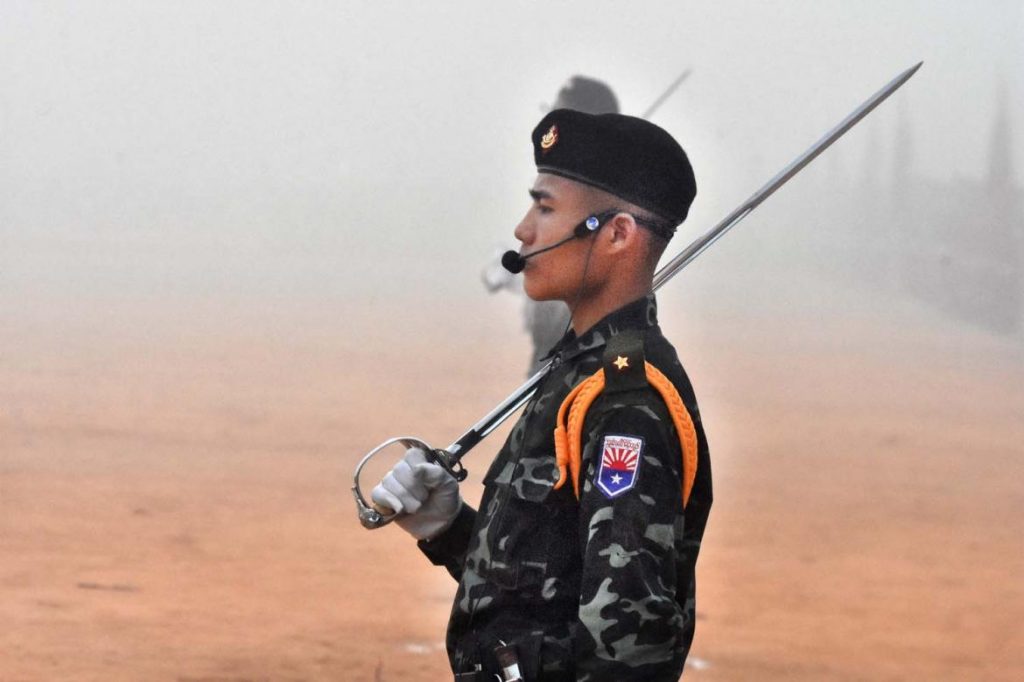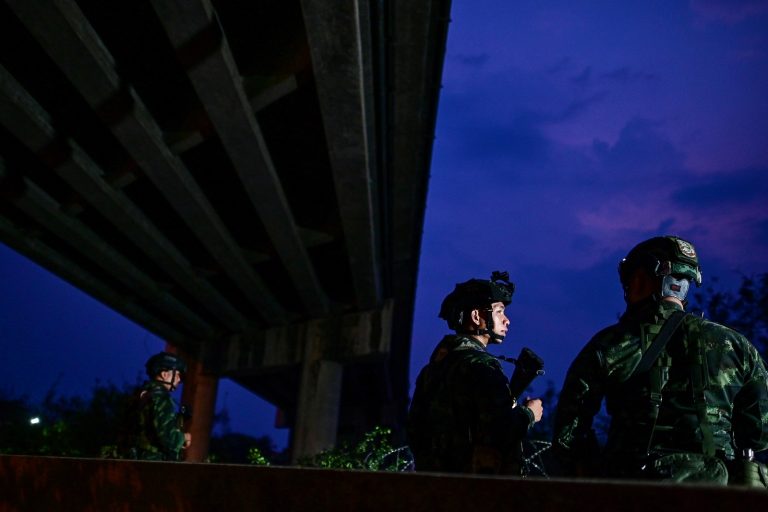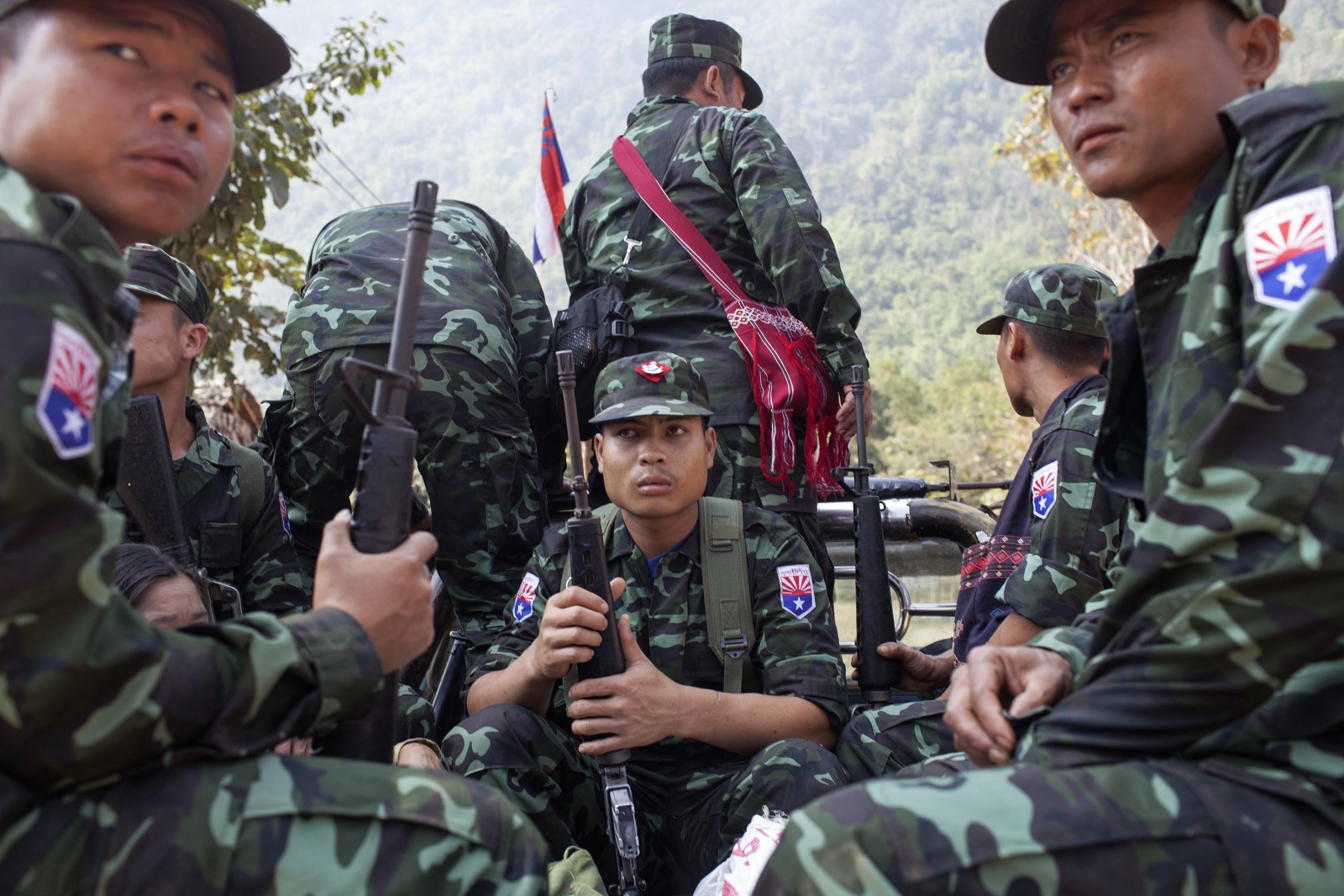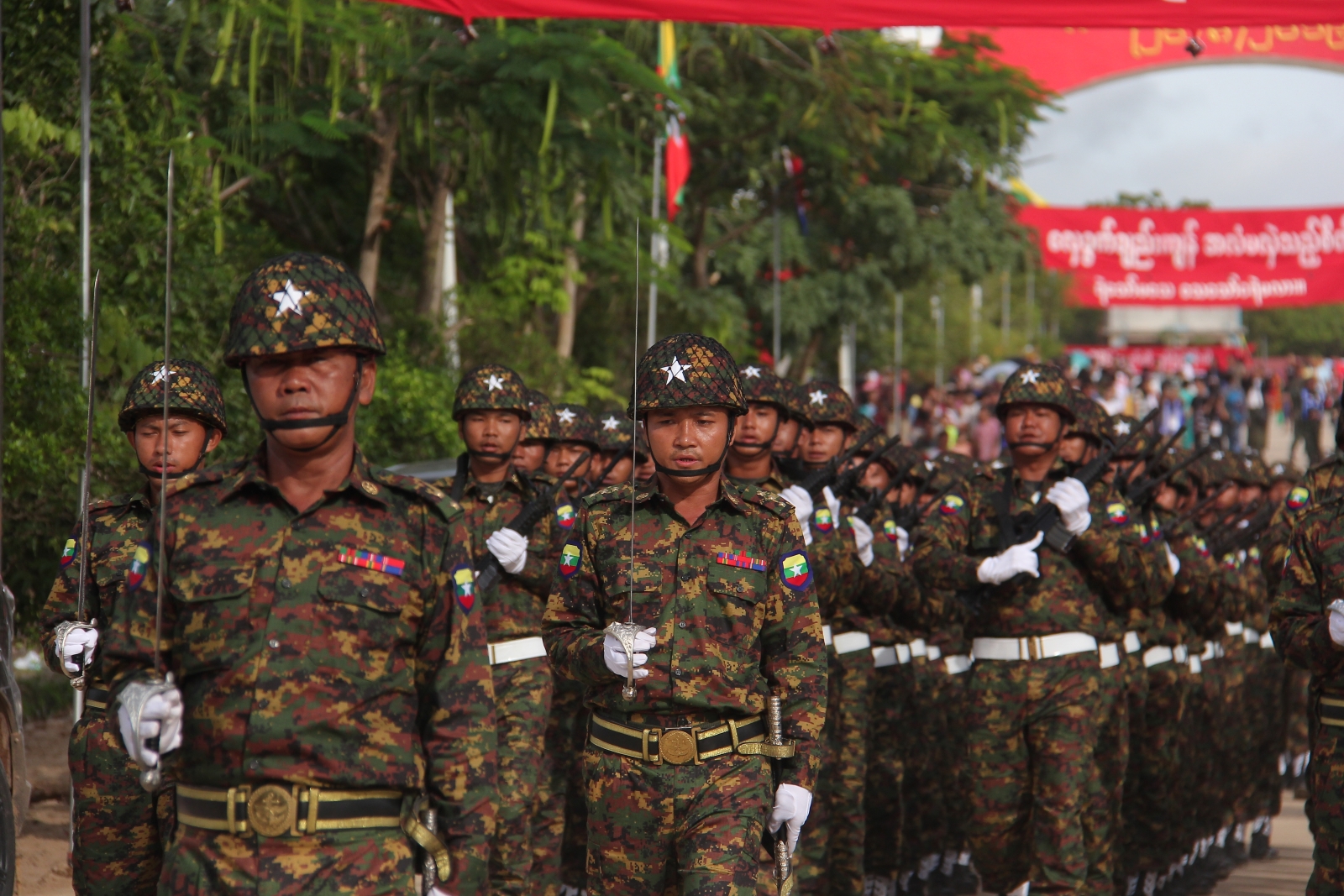The Karen National Union marks seven decades of armed struggle. With peace talks stalled, the goal of Karen autonomy remains remote.
By BEN DUNANT | FRONTIER
AN OLD, SLENDER man in camouflage fatigues and a black beret raised himself stiffly from a plastic chair. His name, rank and long record of military service had been read out and broadcast across a parade ground by the Moei River. As he walked across the flower-decked stage, he faltered. A junior officer came and supported the veteran on his way to the podium, where Karen National Union president Saw Mutu Say Poe stood in a traditional red Karen tunic, a garland of flowers around his neck. Two young women carried forward a gilt-framed award bearing the veteran’s name and achievements, and the two old men saluted each other.
Clutching his award, the man was helped back to his chair, and the name of another veteran was announced. It was the longest section of the ceremony commemorating the 70th anniversary of the Karen Revolution, held on January 31 at the Kayin State village of Klo Yaw Lay, the headquarters of the Karen National Liberation Army’s Seventh Brigade, north of Myawaddy and just across the river from Thailand’s Tak Province. The day had begun with a military parade. The veterans on stage had dusted off old uniforms for the event. Before them on the parade ground, young men of the KNLA were just growing into theirs.
The old men watching from the stage had known war their entire lives. Mutu Say Poe was a boy when, in January 1949, political stalemate between the Bamar, the masters of newly independent Burma, and the Karen over their demands for an autonomous Karen State escalated into full-grown conflict. The civil war had followed the seizure of central Burmese towns by the Karen National Defence Organisation and Karen Rifle battalions recently defected from the Tatmadaw, and massacres of Karen civilians by Bamar militias loyal to Rangoon.
The Karen have not known peace since. A bilateral ceasefire signed on January 12, 2012 has held, but it’s a fragile truce. The ceasefire saw the Tatmadaw move crack troops away from the southeast to northern Myanmar, but it has maintained a forward posture against the KNLA, upgrading bases close to rural populations. Political dialogue on a federal restructuring of power, essential for any peace settlement, is stalled.
Support more independent journalism like this. Sign up to be a Frontier member.
A morning mist cleared over Klo Yaw Lay to reveal a steep, forested mountain overlooking the parade ground. The young soldiers filed out. At the raised margins of the ground, thick with several thousand spectators, women rushed forward to garland the men in uniform – a new generation entering Myanmar’s oldest civil conflict.
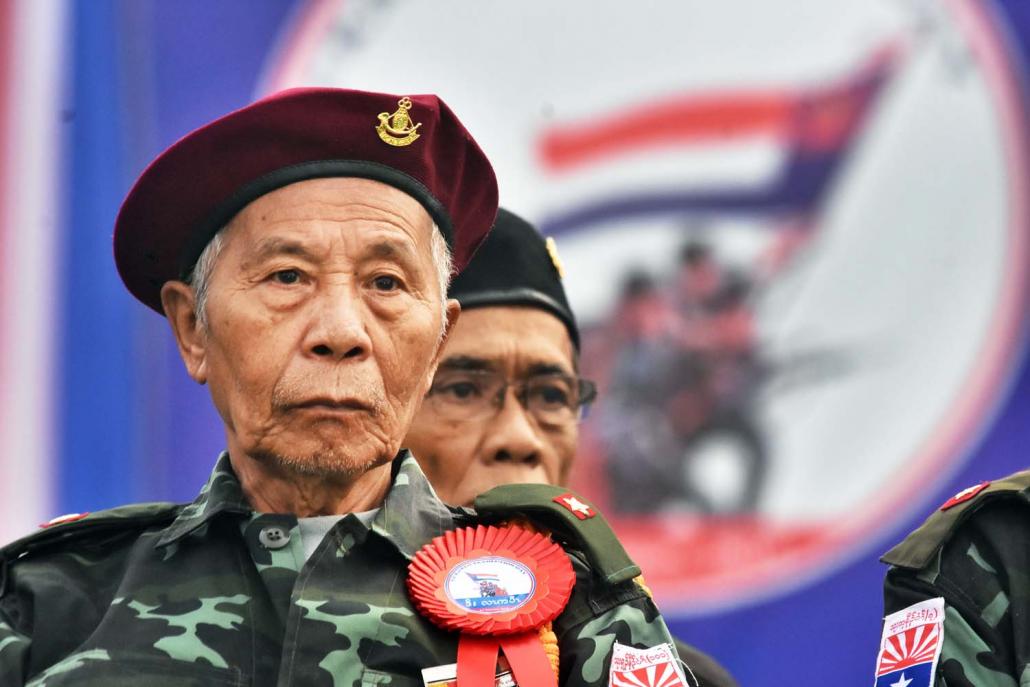
A decorated veteran of the Karen National Liberation Army sits onstage during the anniversary event on 31 January. (Steve Tickner | Frontier)
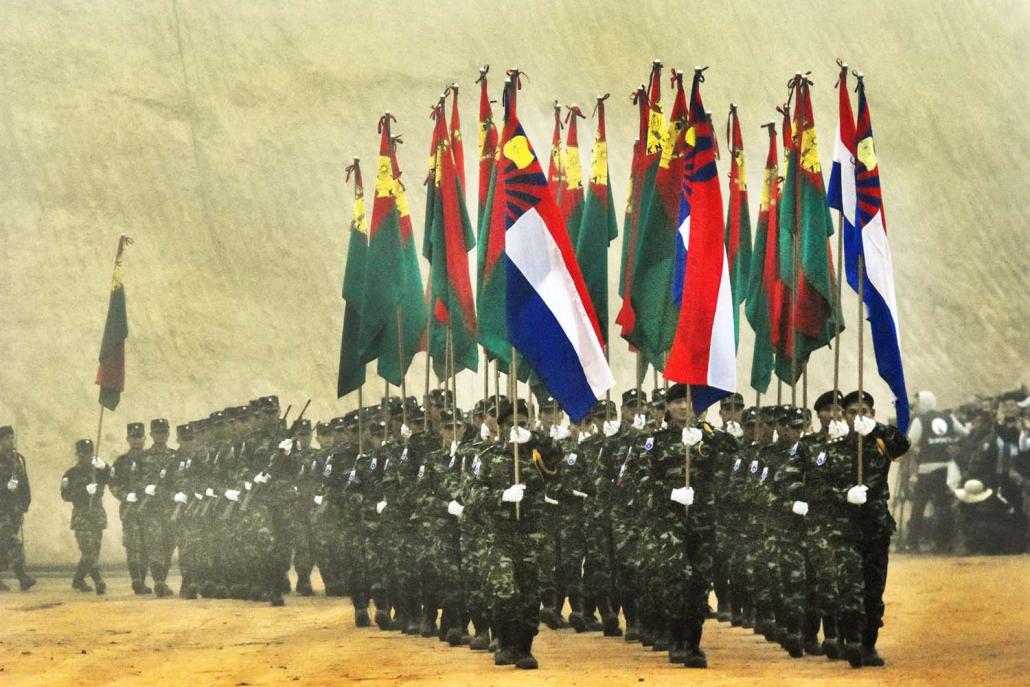
KNLA troops enter the parade ground at Klo Yaw Lay, where KNU’s Seventh Brigade is headquartered. (Steve Tickner | Frontier)
Unity
The parade, speeches and the honouring of veterans marked the culmination of an event lasting several days. Though it commemorated seven decades of war, the mood was like a festival. The dirt lanes of the village were clogged with stalls selling food, drink, plastic toy firearms and Karen clothing. Live rocks bands and traditional Karen dance troupes entertained people all night on large, floodlit stages. More than 10,000 people came, including Karen from elsewhere in Kayin State and throughout Myanmar, and the refugee camps along the border in Thailand.
KNU organisers told Frontier that, though Revolution Day has been publicly marked at Klo Yaw Lay in previous years, and despite parallel events being undertaken in other KNU-administered districts such as Mutraw (which the Myanmar government calls Hpapun) defended by KNLA Fifth Brigade, this was the largest commemoration they had seen. A middle-aged woman, Amina Islam, told Frontier she had travelled to the event from the Kayin State capital, Hpa-an, to open a small restaurant and betel stall at the event venue because the business was so brisk there.
Most attendees interviewed by Frontier said it was the first time they had attended a Revolution Day event. Two women, Naw Kwe Wah, 22, and Naw Eh Say, 20, said they had come from Mae La, a camp for about 40,000 Karen refugees 60 kilometres north of the Thai town of Mae Sot, opposite Myawaddy. They said they were excited to see the KNLA soldiers, whom they had not seen parade before, but were just as excited to meet Karen from across the state, and beyond. A 24-year-old man, Saw Nee, from Mutraw, who was busily taking selfies with friends from other districts, said the whole event “made me proud to be Karen”.
Mingling in the crowd and browsing the merchandise, while cradling assault rifles and the occasional grenade launcher, were uniformed soldiers of the Democratic Karen Benevolent Army and the KNU/KNLA Peace Council. These armed groups emerged from factions of the KNLA that, buckling under relentless Tatmadaw assault or angered by Buddhist marginalisation within the Christian-dominated KNLA, had defected to fight alongside the Tatmadaw. Though keeping a tight hold on their territories and business concessions, these groups have agreed in a series of meetings since 2012 to defer political authority to the KNU, and have allowed it to resume some public services in their areas of control, animated by a renewed desire for Karen unity and a wish to borrow from the KNU’s legitimacy.
The attendance of these groups at KNU-hosted Revolution Day events is not new, but a conspicuous gesture towards Karen unity at January’s event was made by Kayin State Border Guard Force commander Colonel Saw Chit Thu when he bankrolled a traditional Karen don dance tournament, which ended on January 30.
Among Karen armed groups, Saw Chit Thu’s BGF, which is formally under the Tatmadaw’s Southeastern Command, shares the most bitter legacy of conflict with the KNLA. It was formed in 2010 out of the Democratic Karen Buddhist Army, a Tatmadaw-allied group that emerged from a revolt in 1994 among the largely Buddhist rank-and-file of the KNLA against a sometimes aloof and high-handed Christian leadership.
U Thuzana, a Buddhist monk with allegedly close ties to the Tatmadaw’s Military Intelligence, instigated the revolt. Together with the Tatmadaw, the DKBA overran the KNU’s longstanding headquarters at Manerplaw, and in the decades since has been blamed for some of the worst abuses against Karen civilians. The “Benevolent” rather than “Buddhist” DKBA represents a faction that broke away from the main DKBA when it transformed itself into a BGF.
Speaking to Frontier after the parade, KNU general secretary Saw Ta Doh Moo said, “We are hoping for all Karen to be under one banner. All the different Karen armed groups are standing by Saw Ba U Gyi’s principles. But because of our differences, we need to continue working on it.”
Saw Ba U Gyi is the pre-eminent Karen revolutionary icon. The former lawyer and government minister was the first president of the KNU, and was killed in a Tatmadaw ambush in August 1950. His image was displayed prominently at the event in Klo Yaw Lay, alongside the four principles he laid down the month before he died: “Surrender is out of the question; We shall retain our arms; The recognition of Karen State must be complete; We shall decide our own political destiny.”
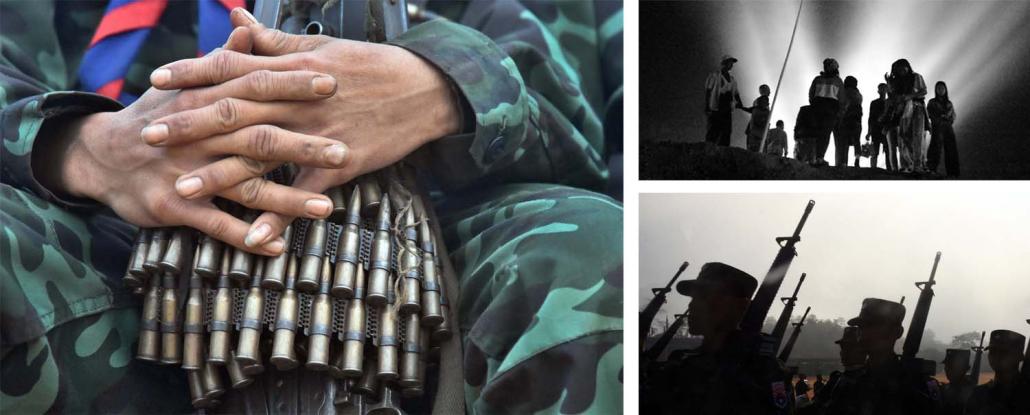
A soldier of the Democratic Karen Benevolent Army observes the parade. (Steve Tickner | Frontier)
Enemies
At a Tatmadaw press conference in Nay Pyi Taw on January 18, Major-General Tun Tun Nyi warned journalists against calling Myanmar’s domestic conflicts “civil wars” because, he said, Myanmar no longer had any civil wars. Coming at a time of fierce fighting between the Tatmadaw and the Arakan Army in Rakhine State, and amid deadlock in a peace process involving the KNU and other armed groups, the statement sparked public incredulity. Tun Tun Nyi went on to clarify: “The civil war ended on May 1949 after the Insein clashes.”
The Tatmadaw general was referring to the Battle of Insein. Karen forces had held the town of Insein north of Rangoon for several months in early 1949, under siege from government troops led by General Ne Win, before relenting in May. However peculiar Tun Tun Nyi’s statement, it nonetheless expressed an important truth about how the Tatmadaw views its enemies across Myanmar: that none of them have come close to representing an existential military threat to the central government since that time when KNU forces were within miles of taking Rangoon.
However, the decades that followed saw brutal fighting between the KNLA and the Tatmadaw. As the KNLA was driven out from its fixed positions in the Ayeyarwady Delta and the Bago mountains of central Myanmar in 1960s and 1970s, and lost much of its territory in the southeastern borderlands in the 1990s, Karen civilians in rural areas bore the brunt of the Tatmadaw’s “Four Cuts” strategy.
The Four Cuts, possibly inspired by British methods used to supress rebellions in colonial Malaya and elsewhere, involves depriving insurgents of funding, food, intelligence and recruits, including by forcibly relocating whole villages.
As documented by the Karen Human Rights Group since 1992, villagers who were relocated, and civilians in general, were often preyed on by soldiers from nearby army bases with demands of food, informal tax and forced labour. According to the KHRG, it was these abuses often as much as active conflict that drove more than 100,000 Karen into refugee camps in Thailand.
Frontier asked Saw Ta Doh Moo about the relevance of the recent Rakhine State crisis, which has brought unprecedented global attention to the methods of the Tatmadaw and the apparent impunity it enjoys. More than 700,000 Rohingya sought refuge in Bangladesh after August 2017, fleeing a scorched earth Tatmadaw campaign that the government says was a legitimate response to attacks by Rohingya militants.
Ta Doh Moo said it was a “tragedy that people need to cross a border just to find shelter and safety. We have faced this in our past, only with less media coverage.”

Women of the Karen National Police Force march in the parade to mark Karen Revolution Day in Ko Yaw Lay, Kayin State. (Steve Tickner | Frontier)
Stalemate
At independence in 1948, distrust and enmity between the different ethnic nationalities in British Burma was profound. Contrary to the contemporary nationalist myth of groups “uniting” to oust the British, they had radically different visions for the country, as well as contrasting attitudes to their departing colonial masters. Nowhere was this starker than between the Karen and the Bamar.
The Karen had been favoured by the British for recruitment into the colonial civil service and the army, putting them at the forefront of the frequently violent repression of Bamar-led resistance movements against British rule. When the overwhelmingly Bamar soldiers of General Aung San’s Burma Independence Army were integrated into the colonial army after World War Two, they entered a force dominated by pro-British Karen officers.
However, as preparations for independence began, Karen politicians were increasingly marginalised. Their demand for a Karen State covering today’s Kayin and Mon states as well as Tanintharyi Region was ignored and Karen delegates did not participate in the February 1947 Panglong Conference between Aung San and Shan, Kachin and Chin leaders, which resulted in an agreement on autonomy for “frontier” areas, and which is held up today as a blueprint for federalism and ethnic equality.
Saw Ba U Gyi resigned from Aung San’s interim cabinet and the KNU boycotted the Constituent Assembly that drafted the first constitution of independent Burma. The creation in 1952 of Karen State, with the same borders as today’s Kayin State and with limited autonomy, did not halt the war.
While other groups, such as the Kachin Independence Organisation and the New Mon State Party, had previously experienced long, largely stable ceasefires with the Tatmadaw, the KNU had to wait till 2012. Since then it has engaged more enthusiastically than any other major ethnic armed group in the peace process launched by President U Thein Sein in 2011 and continued under the National League for Democracy government that took office in 2016.
The KNU was one of eight groups that signed the Nationwide Ceasefire Agreement in 2015 – since joined by two more – while powerful groups such as the KIO and the United Wa State Army remain non-signatories. The government continues to insist that the NCA is a prerequisite for serious peace talks.
Eyebrows were raised when KNU president Mutu Say Poe was photographed receiving a hug from Tatmadaw Commander-in-Chief Senior General Min Aung Hlaing in Nay Pyi Taw in 2013, and again when a photograph surfaced on Facebook of Mutu Say Poe and other senior KNU leaders meeting former dictator U Than Shwe at his opulent home in the national capital in late 2016. Many in Karen civil society feared that the KNU leadership was becoming too close to a military that they fundamentally believed could not be trusted.
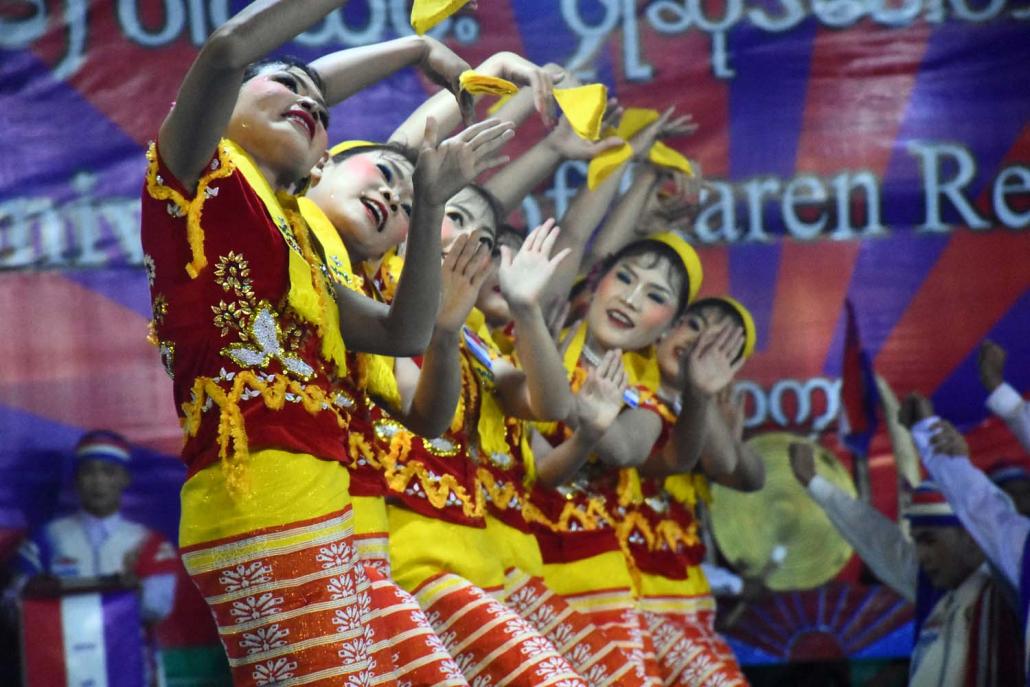
A traditional Karen don dance tournament was sponsored by Border Guard Force commander Colonel Saw Chit Thu. (Steve Tickner | Frontier)
Withdrawal
In October last year, the KNU announced that it was suspending participation in formal peace talks, citing divergent understandings between it and the Tatmadaw over core definitions and principles. This had followed a stalemate over the Tatmadaw’s insistence that ethnic armed groups commit to principles of “non-secession” and a “single army” before political dialogue could proceed. The ethnic armed groups say this went beyond the terms agreed in the NCA, which were supposed to be the basis for political dialogue.
The KNU’s head of foreign affairs, Saw Taw Nee, told Frontier on the sidelines of the event in Klo Yaw Lay that for it and other armed ethnic groups, demands to commit to non-secession from the Union violate a fundamental principle of equality between ethnic nationalities.
“We formed this country via the Panglong Conference, coming together to build the Union. Some ethnic people had the right to secede,” he said, referring to the right granted to ethnic states in the 1947 Constitution. “But no one tried to use it. For us, the issue is non-negotiable, and [a commitment to non-secession] is not in the NCA. If we got equal rights and self-determination, we wouldn’t want to secede from the country. We’d want to live together.”
Meanwhile, ethnic armed groups are suspicious about the demand that they agree to a “single” army in the Union, regarding it as an attempt to have them disarm before a political settlement is reached, a scenario that would doom what leverage they still have in negotiations.
They reject assertions that the Tatmadaw is genuinely a “Union” army, when it is dominated by the Bamar and feared by most minority groups. The ethnic armed groups also see the demand as a barrier to discussing security sector reform, a core area of concern for them, entailing the transformation of Myanmar’s security forces to make them more representative of and accountable to society.
“We don’t disagree with the idea of a single army for the country. But before we combine into one army, we need to talk about security issues more broadly, including basic human security,” said Taw Nee. “But the Tatmadaw says, you have to agree to the single army system first. We can’t accept that.”
“We want civilian supremacy, whereas now we have military supremacy over civilians. But the Tatmadaw says, we’ll be under civilian authority when ethnic armed groups are finished. They say it like that to us directly.”
Dr Ashley South, a research fellow at Chiang Mai University and a long-time observer of the Karen war, told Frontier in a telephone interview that, given the importance of the issues being disputed, “The KNU’s temporary withdrawal from joint elements of the formal peace talks was a wise move.”
“It’s important not to let the government move ahead with a flawed peace accord, which does not address ethnic stakeholders’ concerns or aspirations, just to have something to present at the next election,” he said.
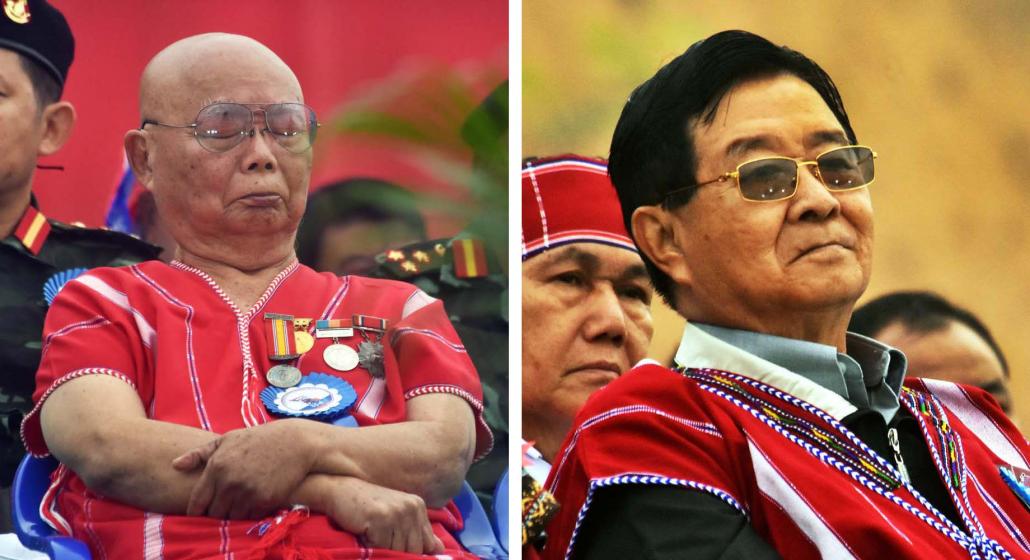
KNU President Saw Mutu Say Poe at ease after delivering a speech to mark the anniversary (left) and Tatmadaw general turned peace negotiator U Aung Min. (Steve Tickner | Frontier)
Exclusion
There are tentative signs that the KNU’s withdrawal from the peace process may have already extracted concessions, though it is uncertain how substantial they will prove to be. Taw Nee said that at informal talks on January 13, government negotiators had agreed to discuss a proposal that the KNU had submitted with other ethnic armed groups in May last year for a phased removal of the Tatmadaw’s representation in parliament and control of ministries by 2030. Previously, he said, the government and Tatmadaw had rejected discussion of the proposal outright.
There have also been rumours that the KNU is courting U Aung Min, a former Tatmadaw general who helped broker the 2012 ceasefire and chaired the Yangon-based Myanmar Peace Center that supported the NCA, to act as a mediator amid the current impasse. Aung Min was a guest of honour at the parade, sitting close to Mutu Say Poe and KNLA chief Saw Johnny and wearing a red Karen tunic. Taw Nee would not confirm this stratagem but described Aung Min as a “good mediator” who had played a “positive role” at the MPC.
Speaking to Frontier after the parade, Aung Min would not say if a formal proposal had been made to him, but said he would re-engage with the peace process if given the opportunity. “For peace, I’d do anything. But it’s unlikely to happen, because it depends on the elected government,” he said, suggesting that the NLD administration would be unwilling to grant him a role.
However, Ta Doh Moo said there were more profound barriers to peace rooted in the Bamar chauvinist mind-set of both the Tatmadaw and the civilian government and the exclusionary nature of the Myanmar state.
“The nature of the government is that it is ruled by the majority Bamar. Through the government’s structure and its policies, and in other ways, the ethnic will is suppressed,” he said. “Even though the government was elected, the government still thinks in a paternalistic way towards ethnic people.”
Ashley South concurred. “The attitudes of the Bamar urban elites haven’t changed,” he said. “There hasn’t yet been a government that has really recognised ethnic grievances and demands for self-determination. In terms of political culture, the NLD and the Tatmadaw are much the same; they share the same authoritarian view of state-society relations.”


